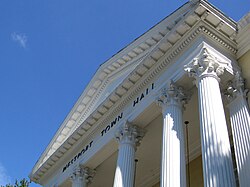Dentil

Closeup of dentils, above a Corinthian order capital, Town Hall, Westport, Connecticut, U.S.

Long view of same
A dentil (from Lat. dens, a tooth[1]) is a small block used as a repeating ornament in the bedmould of a cornice.[2] Dentils are found in classical Greek and Roman architecture and also in later styles, such as Beaux Arts Classicism, Classical Revival, Federal, Georgian Revival, Greek Revival, Neoclassicism, Renaissance Revival, and Second Empire.[3]
Contents
1 History
1.1 Origin
1.2 Later use
2 Gallery
3 References
4 External links
History
Origin
The Roman architect Vitruvius (iv. 2) states that the dentil represents the end of a rafter (asser); and since it occurs in its most pronounced form in the Ionic temples of Asia Minor, the Lycian tombs and the porticoes and tombs of Persia, where it represents distinctly the reproduction in stone of timber construction. The earliest example is found carved into the rock of the tomb of Darius, c. 500 BC, reproducing the portico of his palace. Its first employment in Athens is in the cornice of the caryatid portico or tribune of the Erechtheum (480 BC). When subsequently introduced into the bed-mould of the cornice of the Choragic Monument of Lysicrates it is much smaller in its dimensions. In the later temples of Ionia, as in the temple of Priene, the larger scale of the dentil is still retained.[2]
Later use
The dentil was the chief feature employed in the bedmould by the Romans and in the Italian Renaissance. As a general rule, the projection of the dentil is equal to its width, thus appearing square, and the intervals between are half this measure. In some cases, the projecting band has never had the sinkings cut into it to divide up the dentils, as in the Pantheon at Rome, and it is then called a dentil-band. In the porch of the Studion cathedral at Constantinople, the dentil and the interval between are equal in width, and the interval is splayed back from top to bottom; this is the form it takes in what is known as the Venetian dentil, which was copied from the Byzantine dentil in Santa Sophia, Constantinople. There, however, it no longer formed part of a bed-mould: its use at Santa Sophia was to decorate the projecting moulding enclosing the encrusted marbles, and the dentils were cut alternately on both sides of the moulding. The Venetian dentil was also introduced as a label round arches and as a string course.[2]
Gallery

Dentils on the facade of Palazzo Tarsis palace in Milan, Italy

Dentilwork on columns

Dentils on entablement at Casino nobile, Villa Torlonia, Rome

Dentils running below modillions on a Victorian Italianate house in San Francisco

Interior dentilwork
References
^ Craven, Jackie (March 29, 2016). "What Is a Dentil? What Is a Dentil Molding?". Retrieved 11 August 2016..mw-parser-output cite.citation{font-style:inherit}.mw-parser-output .citation q{quotes:"""""""'""'"}.mw-parser-output .citation .cs1-lock-free a{background:url("//upload.wikimedia.org/wikipedia/commons/thumb/6/65/Lock-green.svg/9px-Lock-green.svg.png")no-repeat;background-position:right .1em center}.mw-parser-output .citation .cs1-lock-limited a,.mw-parser-output .citation .cs1-lock-registration a{background:url("//upload.wikimedia.org/wikipedia/commons/thumb/d/d6/Lock-gray-alt-2.svg/9px-Lock-gray-alt-2.svg.png")no-repeat;background-position:right .1em center}.mw-parser-output .citation .cs1-lock-subscription a{background:url("//upload.wikimedia.org/wikipedia/commons/thumb/a/aa/Lock-red-alt-2.svg/9px-Lock-red-alt-2.svg.png")no-repeat;background-position:right .1em center}.mw-parser-output .cs1-subscription,.mw-parser-output .cs1-registration{color:#555}.mw-parser-output .cs1-subscription span,.mw-parser-output .cs1-registration span{border-bottom:1px dotted;cursor:help}.mw-parser-output .cs1-ws-icon a{background:url("//upload.wikimedia.org/wikipedia/commons/thumb/4/4c/Wikisource-logo.svg/12px-Wikisource-logo.svg.png")no-repeat;background-position:right .1em center}.mw-parser-output code.cs1-code{color:inherit;background:inherit;border:inherit;padding:inherit}.mw-parser-output .cs1-hidden-error{display:none;font-size:100%}.mw-parser-output .cs1-visible-error{font-size:100%}.mw-parser-output .cs1-maint{display:none;color:#33aa33;margin-left:0.3em}.mw-parser-output .cs1-subscription,.mw-parser-output .cs1-registration,.mw-parser-output .cs1-format{font-size:95%}.mw-parser-output .cs1-kern-left,.mw-parser-output .cs1-kern-wl-left{padding-left:0.2em}.mw-parser-output .cs1-kern-right,.mw-parser-output .cs1-kern-wl-right{padding-right:0.2em}
^ abc One or more of the preceding sentences incorporates text from a publication now in the public domain: Chisholm, Hugh, ed. (1911). . Encyclopædia Britannica. 8 (11th ed.). Cambridge University Press. p. 50.
One or more of the preceding sentences incorporates text from a publication now in the public domain: Chisholm, Hugh, ed. (1911). . Encyclopædia Britannica. 8 (11th ed.). Cambridge University Press. p. 50.
^ "Dentil". Buffalo as an Architecture Museum. buffaloah.com. Retrieved 11 August 2016.
External links
| Wikimedia Commons has media related to Dentils. |




